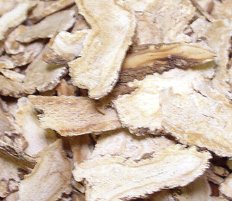Angelica root

  | Angelica root in TCM:Explore the properties of Angelica root according to Chinese
Nutrition and Traditional Chinese Medicine (TCM):
Temperature: warm
Channels: LU, SP, HT, SI
Flavors: sweet, bitter, pungent
Special Properties:
circulates qi, disperses cold, clears damp, disperses wind, resolves phlegm
Angelica is known in Chinese medicine as an herb called Dang Gui, and it is primarily the root of Radix Angelicae Sinensis that is used as medicine. In Chinese medicine Angelica is in the category of herbs that Tonify Blood, and it has the following actions:
- Tonifies Blood
- Invigorates blood; regulates menses; alleviates pain
- Moistens the intestines and unblocks the bowels
- Reduces swelling, expels pus, generates flesh, alleviates pain
The virtues of Angelica were praised by old writers and the name itself, testifies as to the great belief in its merits as a protection against contagion, for purifying the blood, and for curing every conceivable malady: it was held a sovereign remedy for poisons agues and all infectious maladies. Today Angelica is largely used in the grocery trade, as well as for medicine, and in addition to being a common ingredient in Chinese foods it is a popular flavoring for confectionery and liqueurs.
In Western medicine the root, seed, and fruit of Angelica is used as medicine. According to Western herbal medicine sources Angelica may be useful in the following situations:
- heartburn
- intestinal gas (flatulence)
- loss of appetite (anorexia)
- arthritis
- circulation problems
- runny nose
- nervousness
- plague
- insomnia
Some women also use angelica to start their menstrual periods or even to cause an abortion. Angelica may also be used to stimulate urine production and improve sex drive.
In general Angelica is known to stimulate the production and secretion of phlegm and kill germs. It is used as a stimulating expectorant. Some people apply angelica directly to the skin for nerve pain (neuralgia), joint pain (rheumatism), and skin disorders. Angelica is also used for treating premature ejaculation.
Preparation:
To make an infusion pour a pint of boiling water on an ounce of the bruised root. Two tablespoons should be given three or four times per day. The following is extracted from an old family book of herbal remedies:
'Boil down gently for three hours a handful of Angelica root in a quart of water; then strain it off and add liquid Narbonne honey or best virgin honey sufficient to make it into a balsam or syrup and take two tablespoonsful every night and morning, as well as several times in the day. If there be hoarseness or sore throat, add a few nitre drops.'
Another recipe (from Francatelli's Cook's Guide):
'Cut the tubes or stalks of Angelica into sixinch lengths; wash them, then put them into a copper preserving-pan with hot syrup; cover the surface with vine-leaves, and set the whole to stand in the larder till next day. The Angelica must then be drained on a sieve, the vine-leaves thrown away, half a pint of water added to the syrup, in which, after it has been boiled, skimmed, and strained into another pan, and the copper-pan has been scoured clean, both the Angelica and the boiling syrup are to be replaced and the surface covered with fresh vine-leaves, and again left to stand in this state till the next day- this process must be repeated 3 or 4 days running: at the end of which time the Angelica will be sufficiently green and done through, and should be put in jars without breaking the tubes. After the syrup has been boiled and skimmed, fill up the jars, and when they are become cold, cover them over with bladder and paper, and let them be kept in a very cool temperature.'
Another way of preserving Angelica:
Choose young stems, cut them into suitable lengths, then boil until tender. When this stage is reached, remove from the water, and strip off the outer skin, then return to the water and simmer slowly until the whole has become very green. Dry the stems and weigh them, allowing one pound of white sugar to every pound of Angelica. The boiled stalks should be laid in an earthenware pan and the sugar sprinkled over them, allowing the whole to stand for a couple of days- then boil all together. When well boiling, remove from the fire and turn into a colander to drain off the superfluous syrup. Take a little more sugar and boil to a syrup again, then throw in the Angelica, and allow it to remain for a few minutes, and finally spread on plates in a cool oven to dry.
Warnings / Contraindications:
Angelica seems to be safe when used in food amounts, and is generally considered safe as a topical cream. However you should always test a small area first to rule out any allergic reaction. As a precaution Angelica should be avoided during breastfeeding or pregnancy. It’s suggested that angelica can cause uterine contractions, and this could threaten the pregnancy.
Disclaimer: In accordance with our terms of service, by using this web site you agree that none of the information found on this web site constitutes medical advice. You should always consult your doctor before trying any particular food or herbal remedy to treat disease.
Folk remedies presented on this site are designed to address specifc TCM diagnoses, and are not one-size-fits-all. If you would like to learn more about Traditional Chinese Medicine (TCM) and how it relates to Chinese Nutrition, you can book in a free call with a licensed professional. There is no obligation to purchase.
[CLICK HERE for your free INITIAL CONSULTATION] |

